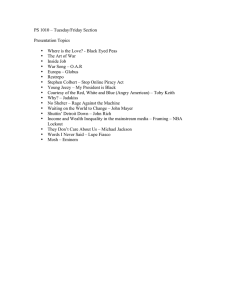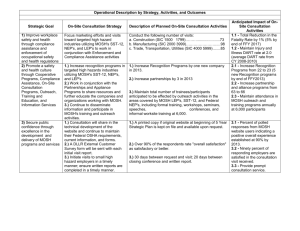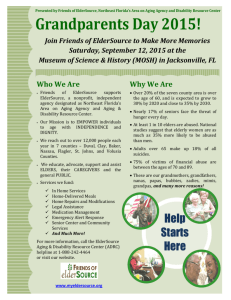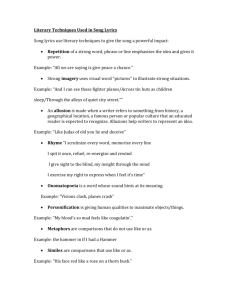Maryland Division of Labor and Industry Occupational Safety
advertisement
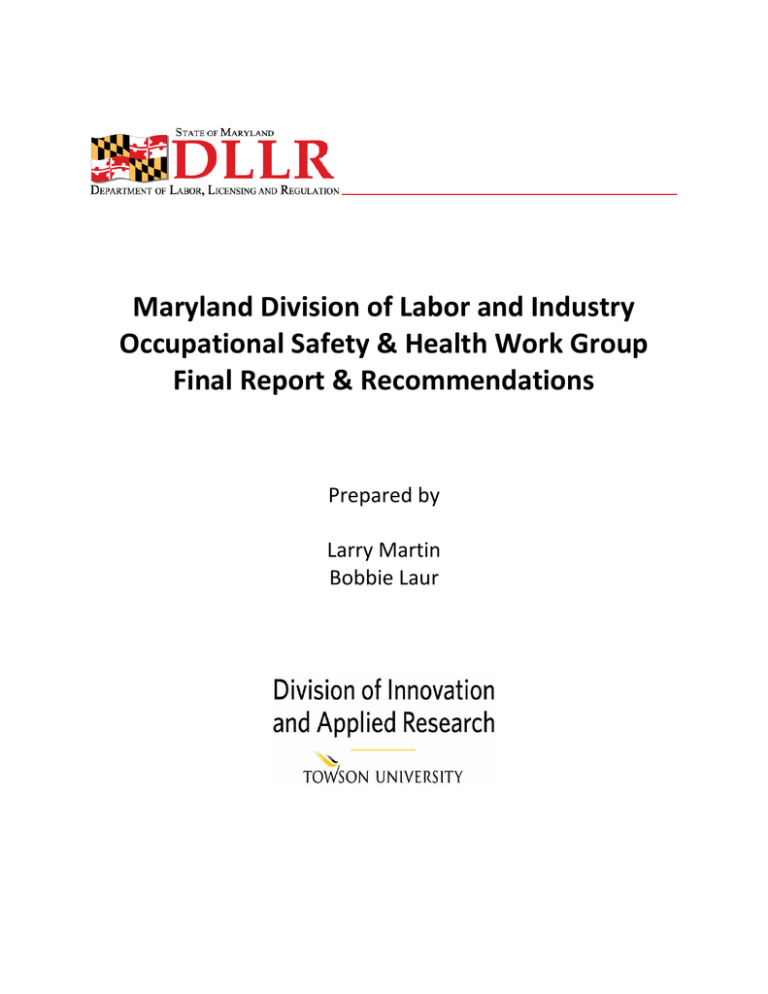
Maryland Division of Labor and Industry Occupational Safety & Health Work Group Final Report & Recommendations Prepared by Larry Martin Bobbie Laur Table of Contents Work Group Overview and Process .............................................................................................................. 3 Membership .................................................................................................................................................. 4 Recommendations ........................................................................................................................................ 5 Conclusion ..................................................................................................................................................... 8 MOSH WORK GROUP – FINAL REPORT & RECOMMENDATIONS 2 Work Group Overview and Process Background There are 27 states and territories that operate Occupational Safety and Health Administration (OSHA)approved state plans. The Occupational Safety and Health Act of 1970 gives states and territories the right to develop their own workplace safety and health plans and to enforce safety and health rules within their jurisdictions. Federal OSHA approves and monitors state plans and funds up to 50 percent of their operating costs. Workers at state and local government agencies are not covered by OSHA, but have OSH Act protections once they work in those states that have an OSHA-approved State Plan. State plans must be as effective as federal OSHA in enforcing safe and healthful working conditions. In addition to their enforcement role, these state plans help employers make safer workplaces with free consultative services, education, and technical assistance. In March 1971, the Governor designated the Division of Labor and Industry as the agency responsible for Maryland's occupational safety and health plan. Authority and enforcement responsibility was assumed on July 1, 1973. On July 18, 1985, the Maryland program received final approval and full enforcement authority in all subject areas covered by the State Plan. The Division works to improve the safety and health of Maryland's working men and women in both the public and private sector by providing consultation services, outreach and educational programs, establishing partnerships, setting and enforcing standards, and encouraging continual process improvement in workplace safety and health. The Division’s occupational safety and health professionals, with the assistance of the MOSH Advisory Board and stakeholders, develops and proposes rules and regulations designed to prevent injuries and occupational diseases in every occupation or place of employment in Maryland. The core component of the Division’s occupational safety and health effort is the Compliance unit. The Compliance Unit is the enforcement arm of Maryland’s Occupational Safety and Health (MOSH) Program. The Compliance Unit is responsible for ensuring that employers meet their duty under the MOSH Act to provide a safe and healthful workplace for employees. They conduct their business through inspections and investigations. The Compliance unit is managed from MOSH headquarters in Hunt Valley and maintains regional offices in Easton and Hagerstown. MOSH Work Group’s Charge & Process Under Governor Hogan and Secretary Schulz’ direction, the MOSH Work Group was constituted to “prepare a report and recommendation to the Secretary to identify ways that will enhance our effort in reducing occupational injuries and illnesses in Maryland, increase procedural efficiencies, and improve customer service and outreach. It is the goal of this Work Group to report to the Secretary its findings, and recommendations, and how the Commissioner should administer and enforce the MOSH Act moving forward.” The MOSH Work Group, with the assistance of Towson University facilitators, convened five times over the course of six months to develop a set of recommendations aimed at improving the MOSH program. Inclusion of ideas from all participants was a priority. A document sharing tool was utilized to post materials in between meetings and create a transparent tool for posting meeting notes. The approach utilized to develop the recommendations was: MOSH WORK GROUP – FINAL REPORT & RECOMMENDATIONS 3 1. 2. 3. 4. Identify issues Come to consensus on most important issues Develop solutions to important issues Identify implementation strategies for solutions Membership The membership consisted of the following: MOSH Work Group Members JoAnn Orlinsky Cliff Mitchell, M.D. Emory Knowles Jack Duley Roy Blades Chair – public member of MOSH Advisory Board Director of Environmental Health, Department of Health and Mental Hygiene, member MOSH Advisory Board Safety and health professional, member MOSH Advisory Board Consultant, Clark Construction Group Private safety and health consultant, former MOSH staff member Kristin L. Klein Jimmy Lien Director of Safety Services, Chesapeake Employers Insurance General Manager, Cintas Corporation Arthur Sapper, Esq. Dave Madaras Frank Truillo LeRoy Myers Frank Ragone Jeff Guido Attorney, McDermott, Will, & Emery President, Chesapeake Regional Safety Council Representative Baltimore ABC County Commissioner, Washington County Regional Safety & Health Coordinator, Cintas Corporation Field Representative, C.H.O.I.C.E. (Community Hub for Opportunities in Construction Employment. Manufacturing representative, Department of Business and Economic Development Carl Livesay DLLR Staff Sarah Harlan Steve Bisson Lashelle Little Brad Meushaw Mike Penn DLI Counsel MOSH Administrator-BLS Industrial Hygienist Safety Consultant Compliance MOSH Thomas J. Meighen Craig Lowry Kim Beard Commissioner, DLI Deputy Commissioner, DLI Assistant to the Deputy Commissioner Facilitators Bobbie Laur Larry Martin Director, Office of Partnerships & Outreach, Towson University Managing Director, IT Services, Towson University MOSH WORK GROUP – FINAL REPORT & RECOMMENDATIONS 4 Recommendations The Work Group has identified seven recommendations to improve the effectiveness and efficiency of the MOSH program. 1. Reaffirm State of Maryland commitment to continue to locally administer occupational safety and health programs, by operating a state plan under the Occupational Safety and Health Act - Section 18 of P.L. 91-596. Early in the Work Group meetings the issue was raised of relinquishing the state plan and allowing Federal OSHA to administer enforcement in place of the Maryland program. The Work Group weighed the value of that proposition, and agreed that businesses would lose-out and nothing would be gained. As an example, first instance sanctions and penalties, although distasteful from a business prospective, are often necessary to gain initial compliance, and keep competitors from making business decisions that place employees’ safety and health at great risk. Additionally, because monetary penalties are mandated by Federal OSHA, and they are required in each state plan, they cannot be escaped. Keeping the Maryland program in place allows the State to continue to respond to emerging injury trends and conditions that impact Marylanders. In addition, the Maryland program is able to offer a variety of collaborative programs that are not available in states where Federal OSHA holds exclusive jurisdiction. The members of the Work Group expressed their unwavering support for the continuation of a state administered Maryland program. 2. Improve the recognition of effective health and safety programs through the MOSH Safety Recognition Program (including the VPP, CCP, SHARP, etc.). The Work Group agreed the MOSH Safety Recognition Program is important and needs to be emphasized and promoted. Many other states have successfully expanded their VPP and other safety outreach programs and have seen significant positive impacts in terms of reductions in workers’ compensation costs and injury rates. The expansion of these programs also needs to include enhanced recognition and visibility when companies achieve one of the awards. Specifically, the Work Group recommends the following actions take place: Simplify the application process by removing requests for duplicate information and developing a web-based single application process, for all employers interested in participating in the MOSH Safety Recognition Program. Define the MOSH Safety Recognition Program value proposition and improve the promotion and awareness the awards available. This value proposition should highlight reduction in workers’ compensation costs and injuries, testimonials from existing award holders, and mentoring opportunities from existing award holders. Complete a needs assessment for sustaining and growing the MOSH Safety Recognition Program in terms of operations, training, and staffing. Create sub work-groups for each MOSH Safety Recognition Program to identify processes and policy changes needed to expand the programs to include all employers. Develop new opportunities for recognition (e.g. safety recognition event or dinner, media announcements for new MOSH Safety Recognition Program awardees, etc.) In support of all businesses in Maryland, codify the VPP existence in law to ensure long-term sustainability. Consult with the Commonwealth of Virginia for lessons learned when the Voluntary Protection Programs (VPP) Act of Virginia was passed unanimously in 2015. MOSH WORK GROUP – FINAL REPORT & RECOMMENDATIONS 5 3. Develop clearer directives and internal policies for enforcement of regulatory violations to ensure consistent interpretation. There was significant discussion that MOSH directives and policies do not clearly define expectations of compliance officers and that directives and policies are interpreted inconsistently. This can lead to confusion as to how to meet and enforce the requirements. One example given was the requirements related to providing an eyewash station where harmful materials could get into an employee’s eye. The installation and maintenance of an eyewash station for emergencies can be interpreted many different ways. Clearly defined requirements eliminate the guess work, providing greater protection for employees and create a more positive relationship with inspectors. Specifically, the Work Group recommends the following actions take place: Develop enforcement policies, in collaboration with stakeholders, for new and emerging safety and health standards. Post all enforcement policies and directives to website. Identify a consultative contact for each sector (construction, manufacturing, etc.) for employers to contact for interpretation and ensure the communication is informally documented. Implement a feedback mechanism to regularly survey employers on what interpretation issues exist so that issues can be identified. 4. Restructure the informal settlement conference to be more flexible and allow citation items to be withdrawn during the conference. Discussion on this issue centered on providing each conferee the delegation of authority to make a decision to withdraw a citation item if warranted at the conference. Specifically, the Work Group recommends the following actions take place: Commissioner should delegate authority to additional individuals to issue/withdraw penalties and citation items. Identify a small number of MOSH staff members that will be involved in informal conferences to ensure more consistency. 5. Improve outreach to industry on an on-going basis. In developing a better relationship between MOSH and industry, members of the Work Group want to see improved communication mechanisms, increased opportunities for feedback, and increased awareness when new or changed requirements are made. There was significant discussion about the challenges with having open dialogue with MOSH and that there is a fear of retaliation for negative feedback. MOSH needs to be seen as part of the team and solution; in order to accomplish this, changes need to be made that facilitate more open and constructive dialogue. Specifically, the Work Group recommends the following actions take place: Develop MOSH Communications Strategy to grow awareness of MOSH consultation and other MOSH services. MOSH WORK GROUP – FINAL REPORT & RECOMMENDATIONS 6 Develop a feedback mechanism and process to provide employers with an opportunity to give both positive and negative anonymous observations regarding MOSH employees and experiences. Create industry-specific peer-groups that provide a venue for developing and sharing best practices focused on new and emerging issues that are causing injury and death. In collaboration with stakeholders, analyze all MOSH business processes to identify a priority order and schedule for redesigning forms and templates to make them more user-friendly (e.g. fillable PDFs and web-based forms). Provide construction employers with the option of requesting a MOSH representative to participate in the pre-construction meetings for state of Maryland funded projects. 6. Implement new training requirements for MOSH employees. While MOSH currently provides professional development and ongoing training for their employees, it was determined that gaps exist in the areas of business operations and customer service. Additionally, the breadth of training available from industry associations and groups is extensive, and these opportunities should be utilized by MOSH. In line with the Augustine Report, numerous businesses when surveyed indicated that interactions with regulatory agents are far too often frustrating, confrontational, inconsistent, time consuming, arbitrary, and generally unhelpful. MOSH employees must receive technical training but they must also receive customer service training designed to improve efficiency, responsiveness, and consistency, thereby improving the relationship between MOSH and the business community. Specifically, the Work Group recommends the following actions take place: Enhance MOSH training program for MOSH employees to include more exposure to business operations and in the field experiences. Leverage existing training opportunities that are offered by other organizations and industry-specific groups to provide increased opportunities for MOSH staff members. Deploy a new customer service training program that is integrated into all work processes to improve efficiency, responsiveness, and consistency for all MOSH employees. Reinvigorate the credentialing program in MOSH (e.g. certified safety professional/industrial hygienist). 7. Conduct study on employee retention to develop set of recommendations for improving employee morale, satisfaction, and retention. The Work Group discussed the challenges businesses face due to the heavy turnover of MOSH staff members, particularly in the compliance unit. In addition to better clarification of directives and increased training opportunities, the Work Group recommends an increased focus on improving employee satisfaction and retention. Specifically, the Work Group recommends the following actions take place: Complete an employee perception survey to identify impediments to job performance and satisfaction. Develop opportunities for subject matter experts within MOSH. Reevaluate the automatic promotion policies. MOSH WORK GROUP – FINAL REPORT & RECOMMENDATIONS 7 Develop a new pathway for promotion and career advancement criteria for MOSH employees, based on performance, knowledge, skills, and ability. Evaluate the need, interest, and opportunity for developing a MOSH employees mentoring program. Review and amend employee recognition opportunities. Conclusion The Work Group wishes to express our sincere appreciation to Governor Hogan and Secretary Schulz for providing us with the opportunity to improve the MOSH Program and ensure Maryland’s employees are safe. The Work Group’s consistent objective was how to make Maryland stronger and safer. While we know some of the recommendations may require further research, we look forward to working with MOSH in implementing the recommendations and making Maryland a more business friendly and safer state. MOSH WORK GROUP – FINAL REPORT & RECOMMENDATIONS 8
